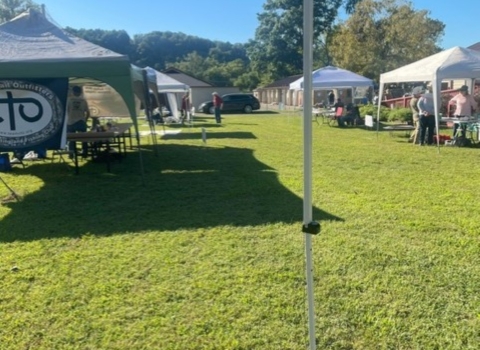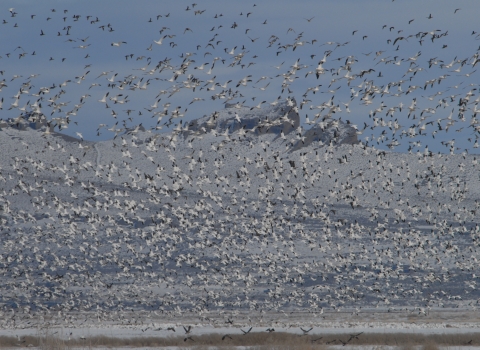Habitat Types
Map
Subtidal Habitat
The muted tidal regimes within the Refuge’s four tidal basins (i.e., Forrestal Pond, Case Road Pond, 7th Street Pond, and Perimeter Pond) support large areas of continually submerged, shallow subtidal habitat. These ponds were created in the early 1990s as mitigation for the Port of Long Beach’s Pier J Landfill project, restoring 116 acres of wetland habitat. Tidal waters from Anaheim Bay enter and exit the restored ponds via constructed channels and culverts that pass under the surrounding roadways.
Eelgrass (Zostera marina) is a type of seagrass that occurs in various locations throughout the Refuge’s subtidal habitat. Eelgrass beds provide microhabitats for invertebrates, small fishes, and important foraging areas for black brant and other types of waterfowl. The roots and rhizomes of the eelgrass help to stabilize the channel bottoms and the eelgrass blades help to cut down wave action, supporting fine sediment deposition.
Mudflat portions of the shallow subtidal habitat within the Refuge are also important because of the invertebrate species that live there. Nematode and polychaete worms, gastropod mollusks, crabs, isopods, and smaller crustaceans transform detritus into food for larger invertebrates and fishes.
Intertidal Channels and Tidal Mudflat Habitats
Intertidal habitat encompasses the area between the high and low tides. This complex tidal channel network ensures full tidal circulation throughout the natural marsh habitat, transporting oxygen and nutrients. These tidal channels are also pathways for fish and other organisms to reach the rich foraging areas within the marsh. Intertidal flats occur between the lowest cordgrass area and the highest eelgrass beds, approximately 3 to 0 feet Mean Lower Low Water (MLLW). The soil is a combination of clay, silt, sand, shells, and organic matter, and the primary vegetation found is algae.
Although generally thought of as unvegetated, mudflats often contain areas of microorganisms, such as diatoms and blue-green algae, which provide food for other species of worms and invertebrates. These invertebrates will also feed on snails, crabs, and polychaete worms, which glean food from the mud substrate and shallow water.
When the tide enters Anaheim Bay, numerous fishes, sharks, and rays move in to take advantage of the productivity of the mudflats. While most mudflat fish are transient visitors, some are full-time residents, usually residing in the burrows of marine invertebrates. Still some other fishes are seasonal visitors only during their juvenile life stages, where the tidal flats serve as nurseries. Tidal channels support important nurseries for species of sport and commercial fish such as California corbina (Menticirrhus undulatus) and California halibut (Paralichthys californicus).
When the tide ebbs, shorebirds appear on the scene to consume invertebrate prey. Each shorebird species is adapted to a certain zone, as revealed in a spectrum of bill lengths and specialized feeding behaviors that correspond to the different lifestyles and niches of mud-dwelling invertebrates.
Coastal Salt Marsh Habitat
Coastal salt marsh salt marsh
Salt marshes are found in tidal areas near the coast, where freshwater mixes with saltwater.
Learn more about salt marsh habitat is composed of salt tolerant vegetation and occurs in the upper intertidal zone above the mudflats. It is within the range of regular tidal inundation and is exposed more often than inundated. Occupying approximately 565 acres, this is the predominant habitat type within the Refuge.
Although shorebirds use salt marsh to a lesser degree than tidal flats, salt marsh does provide nesting, feeding, and a high-water escape area for many species of birds, including the Federally listed endangered light-footed clapper rail and State endangered Belding’s savannah sparrow. The Refuge’s salt marsh habitat also provides food and cover for some 40 species of fish and more than 100 species of marine invertebrates. Nineteen species of plants occur in the salt marsh; however there are 12 main species that dominate. Coastal salt marsh habitat is most often described in terms of elevational zones (i.e. low, middle, and high marsh).
At lower elevations, salt marsh habitat overlaps with intertidal flats and is subject to regular inundation. The predominant plant in this zone is cordgrass. Other plant species found in this zone include pickleweed (Salicornia virginica), saltwort (Batis maritima), and annual pickleweed (S. bigelovii).
Middle marsh elevations typically have saltwort and pickleweed. Other species include arrow grass (Triglochin concinna) and Jaumea (Jaumea carnosa).
The upper zone of salt marsh habitat lies above the mean high tide line and is flooded only during the highest spring tides. Dominant plants include glasswort and pickleweed, with a variety of others such as alkali heath, estuary seablite, alkali weed, salt grass, sea lavender, and shore grass. At Seal Beach NWR, High marsh habitat also occurs in portions of Case Road Pond, around the edges of some of the islands present in 7th Street Pond, and in the Bolsa Cell, located to the north of Bolsa Avenue. The muted tidal regime in this area isolates the salt marsh habitat from full tidal influence, supporting dense stands of pickleweed.
The highest elevations of the high marsh zone are often referred to as wetland/upland transition or upland transition marsh. This habitat zone represents a gradient between the upper marsh, and the coastal sage scrub and maritime succulent scrub habitats that never get inundated by the tides. Unfortunately, no remnants of historical upland transition habitat remain around Anaheim Bay. Some areas adjacent to the marsh habitat do support a few native species, but for the most part, these areas are dominated by non-native weeds and grasses. Other areas have been planted with native upland species in an effort to create a more natural wetland/upland transition zone.
Upland Habitat
The Refuge contains about 65 acres of uplands, most of which were historically wetlands that were filled during the last century to support uses primarily with military and agricultural activities. Approximately 41 acres of these uplands have been developed into roads, berms, railroad tracks, and other structures. The remaining undeveloped uplands consist of non-native grasslands, natural and manmade islands, and native shrub revegetation areas.
Hog Island
The only area within the Refuge that historically supported native upland vegetation is Hog Island, located in the southern portion of the Refuge. None of the original native vegetation exists on Hog Island today, and the area is actually larger today than it was in the past. The three “arms” that extend out from the island consist of fill material placed there to support past military uses. These “arms” were recently planted with native vegetation to support uplands birds, as well as to provide cover for shorebirds and other waterbirds during high tides.
NASA Island
Another upland area within the marsh is NASA Island. This 2.9-acre island is man-made and was constructed for rocket testing in the mid-1960s. It was used for this purpose until about 1977, when the site was turned over to FWS to create a nesting site for the endangered California least tern. To make the site suitable for nesting, it was leveled and portions of the site were covered with sand. Over the years, refuge staff has continued to make improvements of the site for the little terns.
Non-native Upland
The triangular area located to the southeast of the 7th Street Pond currently supports predominately non-native, weedy vegetation such as fivehorn smotherweed (Bassia hyssopifolia), common thistle (Cirsium vulgare), Maltese star-thistle (Centaurea melitensis), milk thistle (Silybum marianum), tumbleweed (Salsola paulsenii), and black mustard (Brassica nigra), as well as patches of native pickleweed. Another upland island, created in Case Road Pond as part of the Port of Long Beach mitigation project, supports native intertidal vegetation at its lower elevations and predominantly non-native, weedy vegetation on the upper elevations near the center of the small island. The Refuge manager employs many different strategies to slow the spread of invasive plants, but it is an uphill battle.

